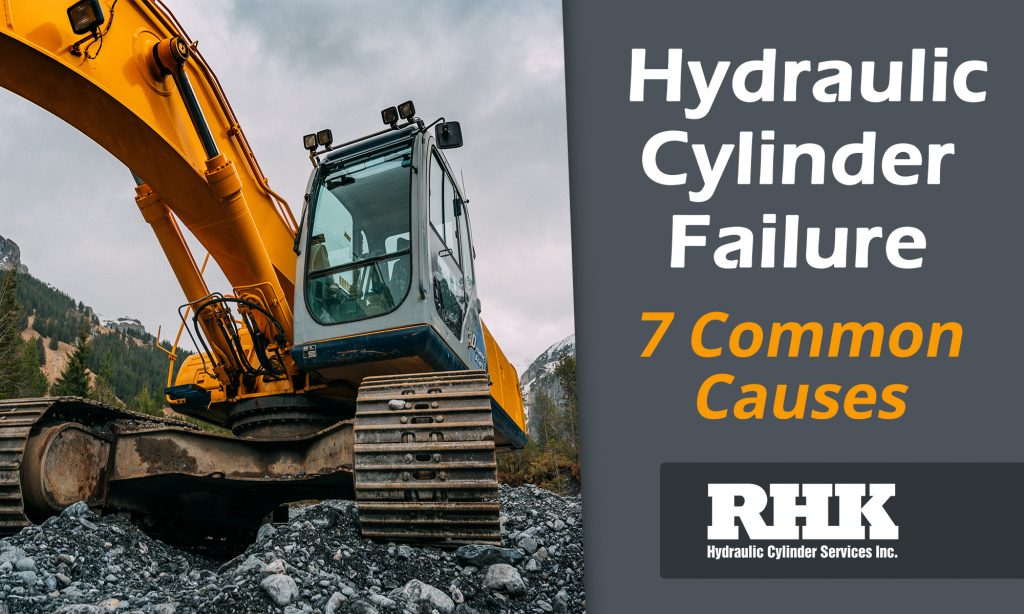
Hydraulic cylinders are the often-overlooked workhorses that provide functionality to a wide range of industrial equipment and mechanical applications. Manufactured for performance in the most demanding environments, they routinely last for years. But despite the inherent power and functionality, hydraulic cylinders still require regular maintenance. When performed regularly, maintenance can be quick with little downtime. If maintenance is ignored or improperly performed, cylinders can and will ultimately fail. To keep your hydraulic system running optimally, it is essential to understand the ways in which it can break down.
Here is a list of the seven most common causes of hydraulic cylinder failure.
- Fluid Contamination
- Seal failure
- Mount Connection failure
- Side loading
- Extreme Temperatures
- Over-pressurizing
- Corrosion
Fluid Contamination
Contamination of the fluid in a hydraulic system is a major cause of hydraulic cylinder failure. Foreign particles introduced into the hydraulic fluid from the external environment can scratch the cylinder bore and accelerate component wear. Liquid contaminates cause oxidation and corrosion of metal parts, resulting in the pitting of chrome and bore surfaces. Seals and fittings can also be degraded leading to internal and external leakage, sticking effects and sub-optimal performance.
Seal Failure
Seals play a critical role in a hydraulic cylinder, containing pressurized hydraulic fluid and preventing leakage between components. Seals can be damaged by excessive heat, improper installation, pressure spikes and contamination – all of which reduce a cylinder’s ability to maintain operating pressure. When seals are damaged, cylinder performance is reduced becoming more and more apparent until they are replaced.
Mount Connection Failure
A cylinder is mounted through various methods: rod or barrel eyes, trunnion, flange and more. When a cylinder is over-loaded or misaligned, excessive stress is applied to the mounting connection which results in faster wear or even failure. Rod eye bushings and bearings can become worn, chipped or broken creating undesirable movement.
Side Loading
Hydraulic cylinders are designed to provide a linear force and motion to move a load. Side loading occurs when an external force is applied perpendicular to the cylinder’s intended orientation. Moderate side loading can result in uneven wear, as the rod pushes against one side of the gland and the piston drags with more force across one side of the barrel. Excessive side loading can create a hazardous situation such as a bent or broken rod.
Extreme Temperatures
Extreme heat and bitter cold temperatures reduce the effectiveness of cylinder seals. Subject to extreme heat, seals lose their shape and effectiveness. Subject to extreme cold, they lose their elasticity and become brittle. Both extremes also alter the viscosity of hydraulic fluid which can lead to external leakage, increased wear and system failure.
Over-pressurizing
Hydraulic cylinders are designed to withstand a specific operating pressure. When subject to excessive pressure cylinder barrels can bulge, snap rings can be dislodged, and operating conditions can become dangerous.
Corrosion
A common problem with hydraulic cylinders is rust and pitting of the cylinder rods and stages. If equipment is stored outside with the cylinders extended, the rods are exposed to weathering. Eventually, the rods will begin to show specks of rust that develop into pits. Once rusting and pitting occur, the rod will destroy the cylinder seal the next time the cylinder is retracted. Using the cylinder on a regular basis will eliminate this problem by creating a micro oil film on the hard chrome plated cylinder rod.
How to Prevent Hydraulic Cylinder Failure
Hydraulic cylinder repair or replacement can throw a wrench in your productivity. The best way to prevent failure is through a regular scheduled maintenance program. Minor issues can be identified and corrected before they become major problems with even greater consequences.
Having issues with your hydraulic cylinder? Contact us! Our technical sales team can help determine the best plan of action to get you back to work.

www.rhkhydraulics.com
Share This:





 CDN NEWS |
CDN NEWS |  US NEWS
US NEWS 





























